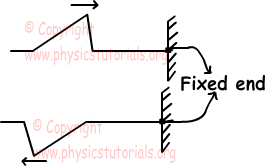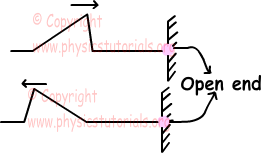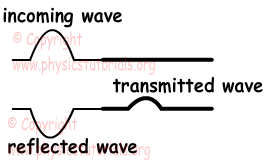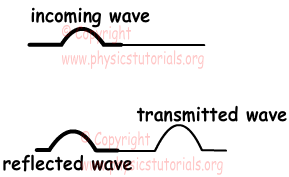Reflection of Spring Waves
Hitting an obstacle and turning back of the wave is called reflection of wave. We examine reflection of sprig waves under two title; reflection from a fixed end and reflection from an opened end.
a) Reflection from Fixed End:
When a pulse of spring wave hits an obstacle having fixed end, it reflects. Reflected wave has opposite direction, same amplitude and velocity with the incident wave. Picture given below shows this process.

b) Reflection from Open End :
When a pulse of a spring comes to an open end obstacle it reflects, like given picture below. Amplitude, velocity and length of the pulse do not change but its right hand side becomes left hand side.
 Reflection from High Density to Low Density and Low Density to High Density:
Reflection from High Density to Low Density and Low Density to High Density:
We add two springs having different thicknesses and send a pulse from the spring having low density to high density. Some part of the pulse is transferred to the high density spring and continues its motion and rest of the pulse reflects. Joining point of two springs behaves like fixed end obstacle. Picture given below shows the behavior of incident, transferred and reflected wave.
 Relation between the velocities of incident transmitted and reflected wave;
Relation between the velocities of incident transmitted and reflected wave;
vincident=vreflected>vtransmitted
When a pulse send from the high density spring to low density spring, some part of the pulse reflects again and some part of it is transmitted. Picture given below shows the behavior of reflected and transmitted pulse.
 Amplitudes of the incident wave and reflected wave are equal but amplitude of transmitted wave is larger than them. Relation between the velocities of incident, reflected and transmitted waves;
Amplitudes of the incident wave and reflected wave are equal but amplitude of transmitted wave is larger than them. Relation between the velocities of incident, reflected and transmitted waves;
vincident=vreflected<vtransmitted
Example: Draw the transmitted and reflected wave of the given pulse below.

 Example: Find the directions of the pulses A and B if the directions of the particles x and y given below.
Example: Find the directions of the pulses A and B if the directions of the particles x and y given below.
 Given picture below shows the pulse A, and its shape after t second. From the positions of points x and y, we can say that this pulse travels along (-) direction and pulse B travels along (+) direction.
Given picture below shows the pulse A, and its shape after t second. From the positions of points x and y, we can say that this pulse travels along (-) direction and pulse B travels along (+) direction.
 Example: There are two waves having equal length and amplitude like in the given picture below. Find the shape of the waves when they overlap.
Example: There are two waves having equal length and amplitude like in the given picture below. Find the shape of the waves when they overlap.
 When two pulse overlap their shape becomes;
When two pulse overlap their shape becomes;
